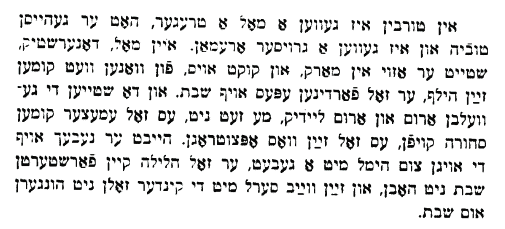| Most Popular Yiddish Language Product Types | |
|
|
|
|
| All Yiddish language product types |
|
|
|
|
|
Language Information
Yiddish until recent times was the language spoken by the majority of the Jews of the world. Prior to World War II more than 10 million people, about two-thirds of world Jewry, spoke or at least understood Yiddish.
Yiddish originated nearly a thousand years ago among Jewish emigrants from northern France who settled in a number of cities along the Rhine and adopted the German dialects of the area. Their speech, however, was strongly influenced by Hebrew, which remained for Jews everywhere the language of religion and scholarship. In the 14th and 15th centuries Yiddish was carried eastward into Poland, Lithuania, and Russia, where it absorbed elements from the various Slavic languages. Thus it is the result of the fusion of a number of linguistic elements, to which it added many unique characteristics of its own.
Yiddish is written in Hebrew characters with the important difference that it uses letters for vowels. German is the dominant element in the language, accounting for about 80 percent of the vocabulary as against 10 percent each for Hebrew and the Slavic languages. Yiddish is exceptionally idiomatic, with many words and expressions that are virtually untranslatable. Many Yiddish words have entered the English language and are now to be found in standard English dictionaries. A few of the best known are chutzpah (effrontery), schlemiel (dolt), schmaltz (sentimentality), and the expression mazel tov (good luck).
The destruction of European Jewry in World War II reduced the number of Yiddish speakers by half. Since that time the number has decreased even further as the younger generation of Jews in America, Russia, and Israel are abandoning Yiddish for the language of their homelands. As Jews continue to emerge from their isolation of past centuries, and assimilate into the modern societies of which they are now a part, the use of Yiddish can only decline even further. It is generally agreed that under these circumstances the long-range future for spoken Yiddish is not bright.
Yiddish is spoken/used in the following countries:
Argentina, France, Germany, Israel, Lithuania, Poland, Russia, Ukraine, United States of America.
Language Family
 Family: Indo-European
Family: Indo-European
 Subgroup: Germanic
Subgroup: Germanic
 Branch: Western
Branch: Western
Copyright © Kenneth Katzner, The Languages of the World, Published by Routledge.
Writing Sample

Translation
Once upon a time there lived in Turbin a porter named Tevye, who was poor beyond description. On a Thursday he was standing in the marketplace, his coattail rolled up under the rope about his hips, and looking about for a possible turn of fortune that would enable him to earn something for the Sabbath. But the stores all about him were empty and void, with nobody going in or coming out, with not a single customer in sight who was likely to need help in carrying bundles. Tevye lifted up his eyes to heaven with a prayer that the Sabbath might pass without sadness, that at least on the Sabbath his dear Sarah and the children might be spared the pangs of hunger.
—ISAAC LOEB PERETZ, Seven Years of Plenty
|


